Main story: CMAP opens new studio and shared business facility in downtown
New site will include video equipment and training opportunities for public access television
Published in the January 25-February 7, 2017 issue of Gilroy Life
By Marty Cheek
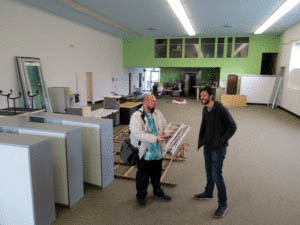
Photo by Marty Cheek
Josh Young, media services coordinator, and Ian Slattery, program director, chat in CMAP-TV’s new downtown Gilroy facility now in the remodeling process.
The long-empty Garlic City Billiards building in downtown Gilroy will next month transform into a state-of-the-art media center for the South Valley region. As remodeling work comes to a close at the new CMAP-TV headquarters, organizers prepare to celebrate its new headquarters with a Feb. 15 grand opening when the public will be welcomed for a peek.
Started in 2000 to serve Gilroy and San Benito County with public access, local government and educational television, CMAP has grown with the evolution of digital technology to serve its media-focused mission in a variety of services. With an acronym that stands for Community Media Access Partnership, CMAP has worked with individuals, businesses and other nonprofit organizations to educate and entertain local residents through media access.
CMAP’s original location was the television studio at Gavilan Community College’s main Gilroy campus. With the opening of Christopher High School, it moved its location to that Gilroy Unified School District site. When the high school required more space and so did not renew its lease with CMAP, organizers realized they needed to find another location. Garlic City Billiards, which prior to that had served as a bank branch, provided the perfect centrally-located spot for the media organization to expand, said Becca King Reed, CMAP’s executive director.
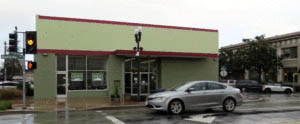
Photo by Marty Cheek
The exterior of the new CMAP building on Monterey Street in downtown Gilroy.
“The reason that started us looking around is that the funding for community television stations has changed,” she said. “It use to be that we would get money from the cable companies like Comcast, AT&T, Charter, those guys, and that money would be used to fund the station and to run it.”
The cable companies changed regulations in California and 10 other states so that community access nonprofits could not use the PEG (public, education, government) money for operating expenses. The PEG fees organizations such as CMAP received is based on a percentage of what people pay for cable service in an area.

Photo courtesy CMAP-TV
“We can buy facilities and equipment with it, but we don’t receive any funds to pay people,” Reed said. “So a lot of cities just gave up their stations because they didn’t want to deal with that. They couldn’t afford to hire people.”
CMAP decided to soldier on in the South Valley by being creative in finding other funding sources for operating its facility and community services. The new location will have a brand-new studio that CMAP members can use to make video content for the cable channel. The studio and equipment can also be rented by nonmember professional video-makers as well as businesses and individuals who might need to make content for websites or training materials, among other needs. With the extra space in the new location, CMAP also developed a “Greenhouse” co-working center at the new site for start-up companies and individual business owners to use for a more professional-looking meeting and working environment.
“So professional videographers can rent the equipment and we make money from that, that’s a revenue stream for us that we can use for operations,” Reed said. “People can buy membership in our co-working center, and that money that we get goes to our operating budget.”
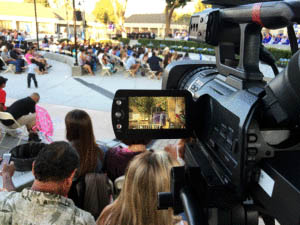
Photo courtesy CMAP-TV
Every time CMAP moves, it needs to build a new media center. So CMAP decided to sign a 10-year lease on its new location, with two five-year options, she said.
“We needed to get a place where we can be for 20 years because we have to amortize the cost, because it’s a very expensive thing to build a television studio,” she said. “CMAP won’t be going any place for 20 years.”
CMAP provides training to local Gilroy and San Benito residents interested in getting involved in making professional-level video content. Because they get access to the studio and equipment at a reduced cost, CMAP members must provide the programming they create for broadcast on the public access cable channel, which in Gilroy is channel 20. CMAP also operates the San Benito County government channel (channel 17), a health and wellness channel (channel 18), and educational programming for all ages (channel 19). Nonmembers pay more to use the equipment but are not required to create programming content for channel 20.
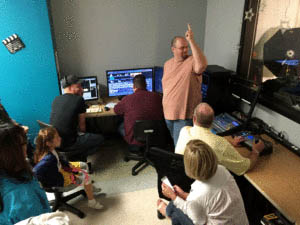
Photo courtesy CMAP-TV
Training young people in media skills is an important part of CMAP’s mission to the South Valley community, Reed said. In San Benito County, CMAP works with youth in schools in learning video-making techniques including claymation and stop-motion animation.
“In Gilroy and Morgan Hill, we are part of the South County Youth Task Force and we have a really nice pipeline for kids to kind of get into at the no-experience level. They get all the experience that they need in video-making,” she said. “The pipeline ends at a project that they get paid for.”
The young people start off at the beginner level by learning to be competent in job-world computer skills such as writing emails and working with Google documents and spreadsheets. They then develop a basic mastery of creating television projects such as writing scripts and using camera and editing equipment.
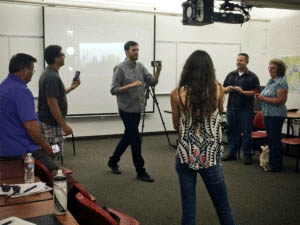
Photo courtesy CMAP-TV
“Once they’ve learned those core competency skills, they move on to do an internship with us and they work on projects that are internal to CMAP,” Reed said.
The young people then can get involved with a video-making project done as a “thank-you gift” for a donor.
“The kids work on that project and they get paid,” she said. “They also get on-screen credit for it. And then they now have job experience. They’ve gone through the training and are certified by us and they can then go out and look for an entry-level job in video. It gives them something to show on a resume.”
The co-working space is an emerging market opportunity in the business world. So CMAP’s board decided their new downtown location could provide a central space for one-person or small local businesses to save money while getting professional services such as a receptionist, conference room, and digital media center. Greenhouse Co-Works will be used as a place for small business owners to meet clients in a location that’s quiet and professional so that they don’t have to go to a home-based office, Reed said.

Photo courtesy CMAP-TV
“For those guys, you can get an office for the day and meet your clients in that building,” she said. “You can also use the address there so your mail goes there and you have a real business address. So when people search you on Google, they don’t get a picture of your garage. They see an office building. There’s all kinds of other benefits.”
These on-occasion users only pay for the space when they use it. Another option allows small business owners to obtain access to a work area on a more regular basis so they don’t need to pay the expenses of having a full-time office. Another option in the new CMAP headquarters is the “Cafe Area” which offers space much like a coffee shop space where people can come in and work on their laptops at a large table with other people, potentially networking with them.
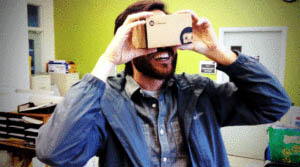
Photo courtesy CMAP-TV
“Our office area is probably much more than you can use as a start-up,” Reed said. “There’s a conference room and digital media options and a nice reception area and we take care of the electricity and the Internet and the heating system. It’s plug-and-play. You bring your laptop in and you’re in business.”
CMAP sees its new location bringing access of state-of-the-art services to individuals, businesses and nonprofit organizations that need to create video and web content but who are not skilled in developing this type of digital programming, she said.
“Video is a great tool for communication,” she said. “And the way things are going now, every website needs video, every business and organization needs to communicate their message clearly. We can help them to create content to communicate their message not only with words but in sounds as pictures as well — people learn better that way, they learn at a deeper level.”
